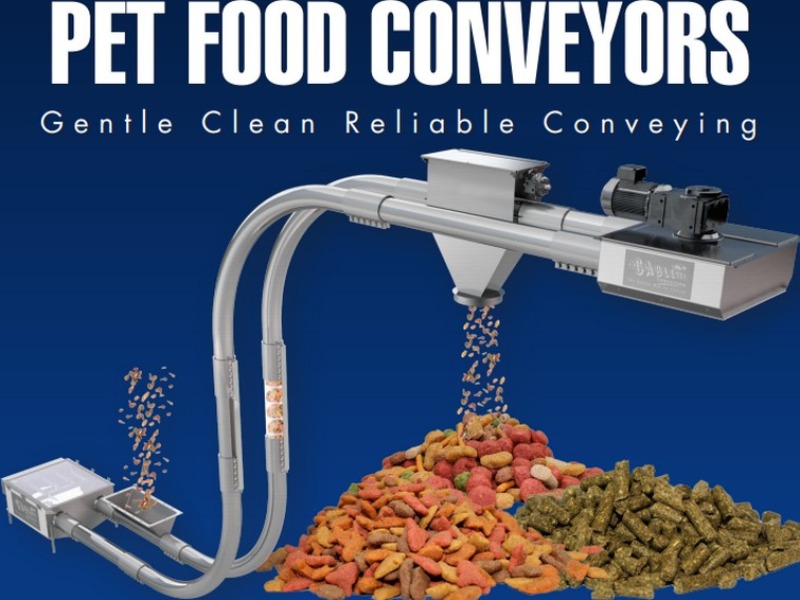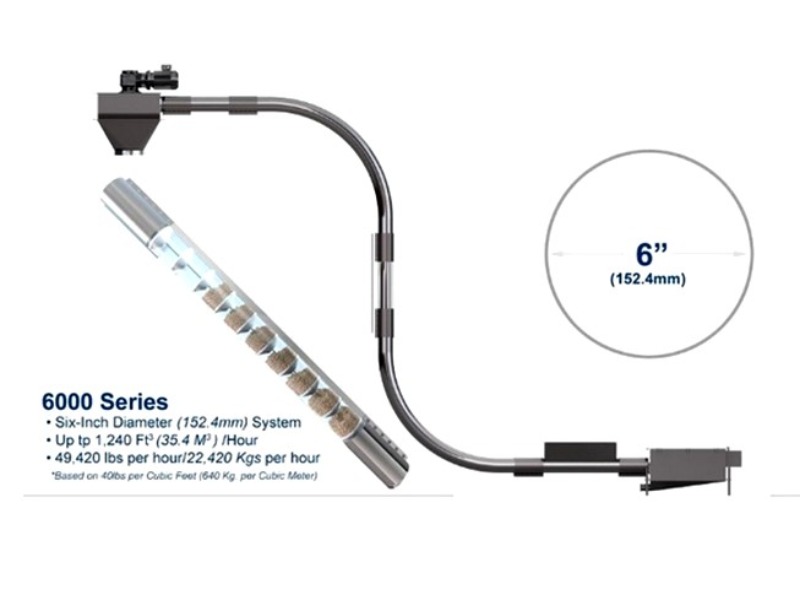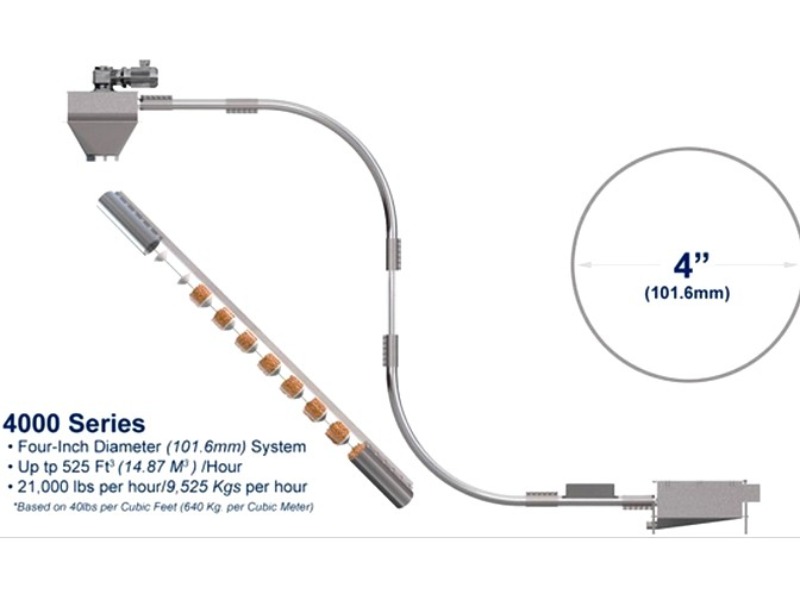

Cablevey Conveyors
https://cablevey.com/
Cablevey Conveyors
About company
Cablevey Pet Food Conveyor Systems
Cablevey Pet Food Conveyor Systems are suitable for moving all sorts of pet food materials and mixes. No matter what form your materials are in, we can move them in a gentle and sanitary manner. And our pet food conveyors can be engineered to service any part of the production process from processing to mixing to packaging.
Flexible Design
Our cable and tube conveyor systems are modularly designed to offer flexibility for wide-ranging applications. Component parts come in a variety of sizes, tube diameters and tube materials. We also offer a full range of feeders, cleaning and transfer system components. No matter what your processing facility layout, we have pet food conveyor solutions for you.
Custom Solutions
Each and every pet food conveyor system is custom specified by our engineering department. This ensures that all systems are optimized to client needs. Design considerations typically include how much can be moved without breakage, how far, how high, and how fast you need to move materials. The configuration and available space within processing environments are also taken into consideration. Bottomline, our engineers and library of system parts can solve just about any pet food conveyor movement needed.
We’ve engineered pet food conveyor solutions for production facilities large to small.
Products
Company News
 Conveying Systems
Conveying Systems

6+ MIN





04/12/2023
Countdown to Pet Food Conveyor Launch: Starting Up On Time and With Confidence
To move delicate pet food products or powders, most processors do extensive homework before purchasing a tubular drag cable conveyor to ensure that it meets their needs in terms of function and price. After the purchase, the conveyor must be expertly assembled and tested to ensure smooth production startup and continued performance. The challenge is that the typical third-party contractors installing various plant systems might need to become more familiar with specialized pet food conveyors and, thus, are more prone to make costly errors. A more prudent choice is using the OEM's team of experienced technicians. The OEM's experts have the advantage of designing the specialized conveyor and understanding its installation, operational requirements, and potential problem areas. 'If a tubular drag cable conveyor is installed incorrectly by a third party, it often needs to be completely pulled apart and rebuilt, which is costly and time-consuming. If the conveyor is run incorrectly, damage will occur, and components must be replaced. All this only delays startup,' says Terry Derby, Director of Parts and Field Service for Automated Handling Solutions (AHS). AHS is the service-focused subsidiary of Cablevey Conveyors, an Oskaloosa, Iowa-based conveyor manufacturer that has been designing, engineering, and servicing enclosed cable and disc tube conveyors for 50 years and is in more than 65 countries. As a solution, pet food processors seeking superior conveyor performance from the start rely on expert-supervised installation and commissioning to ensure they will be ready to run products on time, at the necessary volumes. Today, a tubular drag cable conveyor requires considerable expertise to install. These systems gently move material through a sealed tube using a coated, flexible, stainless-steel drag cable pulled through on a loop. Solid circular discs (flights) attach to the cable, pushing the product through the tube without air. 'This type of conveyor is uniquely engineered to transport delicate materials gently. The tubes form a continuous loop that must be carefully assembled for a tight fit to ensure no misalignment or gaps between sections. While the modular components lend great flexibility to system design, each component must act in concert with the rest for proper conveyor functionality,' explains Derby. After selecting and purchasing a conveyor, the pet food processor's next step is installing it, which often requires professional assistance. Reliability Starts with Supervised Installation Whether relying on internal staff members for installation or contracting the job to an outside team of millwrights or skilled pipefitters, supervised conveyor installation can ensure proper system installation. Getting expert assistance is still essential during installation, even with the manual that has detailed instructions and QR-code links to videos for each conveyor component. 'Supervised installation is important to ensure that your system is installed properly so you don't run into maintenance problems due to an improper install,' says Derby. Derby insists that 'supervised installs are probably the most important support service we offer.' This step is often neglected when a less experienced third party performs the installation, which can escalate costs. At this point, AHS is frequently asked to complete final preparations and correct any problems before production startup, a process known as commissioning. 'When a processor brings us to their facility after declining a supervised installation, we often have to work backward for a day or two to correct issues. Having us there for supervised installation eliminates the need for correction and any idle contractors waiting on us for the repair, so it pays for itself,' says Derby. In the case of AHS, the company's technicians have logged hundreds, if not thousands, of hours on-site in various manufacturing facilities worldwide. This singular focus gives them the knowledge and expertise to streamline the installation process and prevent issues that can lead to system inefficiencies, product loss, or complete system failure. As part of the supervised installation, skilled technicians ensure the correct positioning of the conveyor's hangers and the proper torque for couplings. The system is properly cleaned to remove any metal fragments or foreign contaminants introduced during installation. In addition, the technician confirms that all conveyor inlets are in place and that all discharges are functioning. Even seemingly minor gaps or misaligned areas in the conveyor tubing can become a severe issue. 'If gaps are in the conveyor's tubes, the discs will 'catch' when crossing the joint, causing excessive wear on the cable and motor. If not corrected, this could lead to premature failure, production downtime, and added repair and replacement costs,' says Derby. According to Derby, another common wear item in tubular drag cable conveyors is sweeps, areas where the tube changes direction. He explains that sweeps are where the cable is under the most significant tension and where the discs rub inside the tube. Since sweeps show the first signs of wear, proper installation can reduce the wear and significantly prolong tube and cable life, simplifying maintenance. 'With a supervised install, processors can ensure that their conveyor is assembled correctly to enable seamless startup, reliable production, optimal output, and greater longevity for the system and its parts. Our reputation is on the line to get it right from the start,' says Derby. In addition, a supervised installation includes a full report outlining actions to correct any issues found. Due to the attention to detail, a supervised installation also preserves the standard warranty for the system's components. Of course, operators also play a critical role in conveyor performance. For this reason, having experts onsite can be one of the best ways to train the operators and maintenance crew on properly running, cleaning, and maintaining the system. Reliable Production Requires Expert Commissioning When the installation is complete, the next step is to schedule commissioning. The average commissioning visit for a single-system installation usually lasts an entire day. The onsite commissioning process readies the conveyor for total production and identifies any immediately correctable issues to keep the startup on schedule. At this point, the system must be installed entirely, including all mechanical and electrical components. The conveyor material must also be ready for introduction to the system. This is where a botched installation by a third party can come to light without supervised installation by the OEM. 'We are often asked to 'fix' poor installations by third-party contractors. We have had to tear whole systems apart. This frequently requires a complete rebuild and replacement of damaged parts, which adds cost, creates downtime, and delays startup,' says Derby. In the case of AHS's commissioning service, the technician conducts an inspection using a camera that runs through the entire system layout to ensure that everything is correctly assembled and ready for testing. The technician then performs a test run of the product, from the inlet feed through the sweeps to the discharge outlet, and verifies that it flows at the desired speed. 'Tailoring the conveyor to the material conveyed can require adjustments to fine-tune the process. With the commissioning, the goal is to increase efficiency, production volume, and reliability,' says Derby. He adds that 'checking the system's health' also uncovers any issues that might arise, which technicians can address to prevent production downtime. He points out that commissioning also extends Cablevey's standard warranty. As a final step in the commissioning process, the technician issues a report for the processor that documents all findings from the full-system inspection. Completing conveyor installation, commissioning, and start-up is only the start of the OEM's and processor's relationship since the system's lifespan can be decades. In addition to traveling on-site for emergency service calls, the company offers an annual service visit to conduct a detailed system inspection and address any issues, identify worn parts, ensure predictive maintenance is being conducted, and provide any additional training needed. This complete system audit aims to extend the conveyor's lifespan and prevent unexpected downtime. 'Our mission is to provide conveying equipment and ensure it performs as required, with minimal downtime and maintenance. Once a pet food processor buys a system, they become part of our family. We will continue to support them every way we can, even as their needs evolve,' concludes Derby. By Del Williams is a technical writer based in Torrance, California. Source All Pet Food
 Conveying Systems
Conveying Systems

4+ MIN





27/11/2023
Mobile 'Smart Cart' Automates Food Conveyor CIP for Pet Food Manufacturers
To promote food safety and sanitary compliance, pet food manufacturers are increasingly seeking the ability to clean-in-place (CIP), an automated method of cleaning the interior surfaces of tubular drag conveyors without disassembly. Now, with the advent of mobile tools like an innovative 'smart cart' that quick-connects to any tubular conveyor and enables simple, customizable 'single button cleaning recipes,' CIP is becoming easier, faster, less labor-intensive, more repeatable, and almost fully automated. Tubular drag conveyor systems gently move product through a sealed, enclosed tube using a drag cable and circular discs pulled through on a loop, so they are ideal for delicate items. Designed to handle a variety of different forms and sizes, from kibble to seeds or pellets and nutrients, tubular conveyors maintain both quality and proper proportions. In a wet CIP process, the system is flooded with water, flushed, rinsed, cleansed, and thoroughly sanitized. Although the process is very effective, streamlining its automation and simplifying the process for all a facility's tubular drag conveyors has been a priority for leading innovators in the industry. 'The standard system required port hookups to water lines and installing piping. The processor also had to make decisions, such as which water temperatures to utilize, or whether to use a cleaning solvent - and the correct amount to add manually,' says John Adair, Engineering and Quality Director for Cablevey Conveyors, an Oskaloosa, Iowa-based conveyor manufacturer that has designed, engineered, and serviced enclosed cable and disc tube conveyors for 50 years, and is in more than 65 countries. To simplify the wet cleaning process, Adair and his engineering team at Cablevey have developed a small, mobile 'smart cart' with integrated water line hookups that a single technician can easily take to any tubular drag conveyor in a facility. The cart is specifically designed to be a fraction of the size of similar carts on the market to facilitate mobility. When the cart is in position and connected to water lines, the CIP process is automated and controlled by a programmable logic controller (PLC) that reduces the need for manual labor and virtually eliminates the risk of improper cleaning. 'Once it is set up, all you do is press a button, and it will bring in the required amount of water at the correct temperature with the necessary amount of solvent for cleaning,' says Adair. The smart cart is designed to store and utilize pre-programmed CIP recipes to flush various residual materials from the tubular drag cable conveyors in a facility before new production runs. The cleaning recipes enable even those with very little training to use the cart, which is helpful in today's tight labor market and allows the technician to move on to other tasks once the cleaning process begins. The use of easily executable recipes ensures a superior, repeatable clean that essentially 'error-proofs' the process. This is particularly important when the technician may be new or less familiar with the production equipment. 'Depending on the product conveyed, sometimes all you need is a wet rinse or a specific cleaning solvent. All that information is saved, so after the first cleaning, it can be automatically repeated. Just push a button to start the appropriate recipe, whether you have one conveyor running multiple products or dozens of conveyors running various products,' says Adair. To meet strict compliance standards, the smart cart also documents all critical CIP information, such as water volume and temperature, chemicals used, and cleaning time by date, in an easily retrievable data log. Since decreasing production downtime between conveyor cleanings is a priority for pet food manufacturers, Cablevey provides new capabilities with the cart that expedites the CIP process. Currently, the CIP process floods the tubular conveyor system but is not designed to clean the discs specifically. 'Operators would manually clean each disc and advance the system disc by disc when the discs had to be cleaned of particularly viscous substances,' says Adair. Once it is set up, all you do is press a button and it will bring in the required amount of water at the correct temperature with the necessary amount of solvent for cleaning. Now, as an option on the cart, a disc washer can be integrated with the conveyor turnaround to spray a pressurized cleansing solution on the discs. This helps to remove stickier substances that could remain after routine CIP cleaning. 'The disc washer sprays high-pressure water directly on the discs, so it acts like an automatic car wash. At the push of a button, the discs and cable are run through, and spray cleaned, which reduces CIP time and eliminates the need to manually clean the discs,' says Adair. To further reduce downtime, Cablevey also offers a new sanitary blower option. 'After the wet CIP process, a sanitary blower attachment on the smart cart can dry the discs and other parts of the system 75% faster than typical air drying,' says Adair. He points out that the faster the conveyor is cleaned and dried after a product change, the sooner it can be put back into service, which improves profitability. According to Adair, Cablevey's Mobile Smart Cart was already available since it was officially unveiled at Pack Expo, a premier packaging and processing show held at the Las Vegas Convention Center in September. The event featured full-scale setups of machinery in action. The company also offered traveling demo smart cars to customers in September for free so clients could test drive the units. Pet food manufacturers can now purchase the demonstration unit used in their facilities, with hands-on training available immediately. While the pet food manufacturing industry is aware that automated CIP can improve conveyor system production uptime, barriers to implementation have slowed adoption. Utilizing a mobile smart cart with integrated water hookups will help manufacturers easily implement CIP in tubular drag conveyors throughout their facilities: expediting conveyor cleaning, production changeover, and sanitary compliance. By: Del Williams - Technical writer based in Torrance - California Source: All Pet Food Magazine
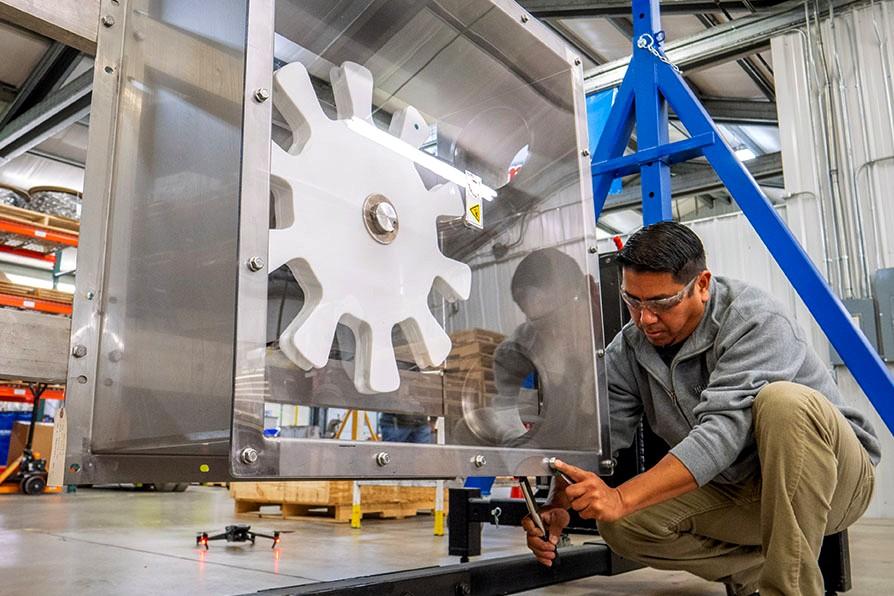 Conveying Systems
Conveying Systems

4+ MIN





29/08/2023
New German test facility allows processors to try solutions before they buy
These systems come as an investment, making it crucial for manufacturers to understand what they're buying before pulling out the company credit card. This is where OEM test facilities come into play, which offer processors the opportunity to try before they buy, often supported by the expertise of seasoned process engineers and salespeople who represent the supplier and its solutions. Testing, testing According to Emmanual Ricohermoso III, Ph.D., testing and facility manager at Automated Handling Solutions (AHS) Germany GmbH, parent company of Cablevey, testing equipment before making a purchase is a progressive approach that can optimize design and material selection for durability, efficiency and environmental impact. 'From the client's perspective, conducting product testing offers them the valuable opportunity to experience the device firsthand before making a purchase commitment,' Ricohermoso added. 'It allows them to assess the device's performance, functionalities and suitability for their specific needs without the obligation of buying it outright. Additionally, during the testing phase, clients can engage directly with our knowledgeable team, leveraging their technical expertise to address any questions or concerns they may have. 'This interactive experience fosters better communication and understanding between our team and the clients,' he added. 'Ultimately, seeing the device in action reinforces the clients' belief and confidence in its capabilities, validating the effectiveness of the solution being offered, or simply, 'to see is to believe.'' The company's 645-square-meter (6,942-square-foot) testing facility is centered around a test workshop equipped with product transfer systems from brands that fall under the AHS and Advanced Material Processing (AMP) umbrella, including Cablevey, Spiroflow, Kason and Marion. The test workshop itself accounts for 71% of the total space. According to Ricohermoso, the German test facility was designed to not only enable testing of conveyors and material transfer systems from point A to point B, but to also integrate relevant processing steps including bag conditioning, bulk bag discharging and filling, dewatering, sieving, mixing and drying. 'Additionally, the test facility boasts a cutting-edge, in-house laboratory dedicated to material characterization,' he noted. 'This enables our engineers to gain a deep understanding of the material properties, allowing them to design tailored solutions that meet the specific needs of our customers. The Friedrichsdorf test facility is now up and running and saw its first customer in early May 2023. Ben Ayrton, managing director and vice president of operations and supply chain for AHS and AMP in Europe, noted that the facility is now fully operational and offers more than 50 products for customer trials and testing across all four brands. 'We are immensely proud to have the most comprehensive testing facility in Continental Europe,' Ayrton said. 'Our expansion and future is exciting, as in addition we are looking forward to introducing a brand new 5,500 m square production facility in the UK in the first half of 2024.' The Friedrichsdorf facility will serve multiple AHS and AMP brands for testing, spare parts, European engineering and sales, as well as aftermarket spare parts and maintenance teams. Prioritizing positive client experiences Understanding why clients want to test or compare equipment performance is the No. 1 consideration when developing a test plan. For example, Ricohermoso said one of the main focuses for today's pet food processors is throughput. Once he has a better idea of a client's priorities, Ricohermoso requests a Material Safety Data Sheet (MSDS) to better understand the handing requirements and potential risks related to the product or material in question. He also asks for cleaning, process flow integration, and tolerance information to create a comprehensive test plan for the client. 'If the client's primary objective is to observe the operation without specific test requirements, I take the initiative to design the test plan myself,' Ricohermoso said. 'The clients are then given time to review the plan internally and communicate any concerns they may have. 'By following this streamlined process, we ensure that the test day runs smoothly, with clear communication and alignment between our team and the clients.' Leaning on OEM expertise Cablevey operates in more than 66 countries and has delivered its solutions for the food, pet food, coffee, powder, nut and frozen food industries for over 50 years. Such equipment includes enclosed cable and disc tube conveyors. 'Cablevey provides a gentle conveying solution, making it particularly suitable for products that are sensitive and have low tolerance for breakage,' Ricohermoso said. 'Its unique conveying method ensures that fragile products can be transported without compromising their integrity or quality.' At Cablevey's stateside test facility — which is located in Oskaloosa, Iowa — the company recently launched a 360-degree immersive experience enabling virtual visits in real time. A Zoom-meeting format developed during the COVID-19 pandemic now allows Cablevey to showcase test runs of its machinery in-person and online simultaneously, which provides convenience for those unable to travel or larger work groups, according to the company. Ricohermoso noted the company plans to add this capability to the German test facility over the next few months.
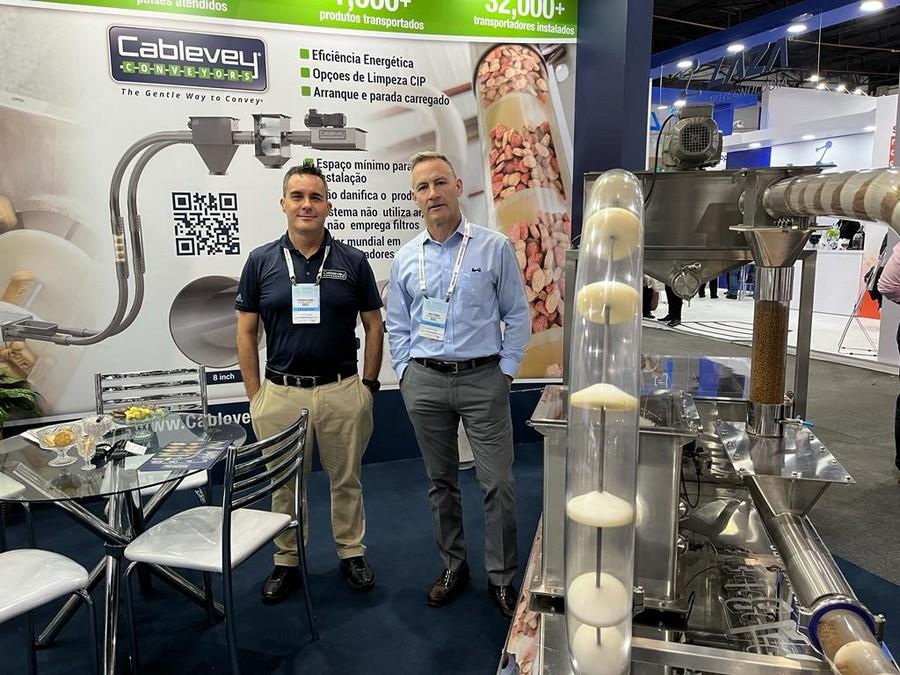 Conveying Systems
Conveying Systems

1+ MIN





25/08/2023
Automated Handling Solutions at FENAGRA 2023 in Brazil
Brad very brieflly introuced himself and the Company, the owners of Cablevey Conveyors and Spiroflow, and highlighted its prsence in the pet food sector. Brazil has been a key market for them within the LATAM region, so they have already planned to grow agresively in that market About Automated Handling Solutions AHS combines expertise in specialty conveyor and material handling and automation equipment technologies to help processors manage their lines effectively and efficiently. AHS' products target applications in high value environments and can support both wet and dry media. Primary end markets served include food and beverage, pharmaceutical, nutraceutical, specialty chemical, and high value industrial. AHS is May River Capital's (May River) newest platform company. by All pet Food
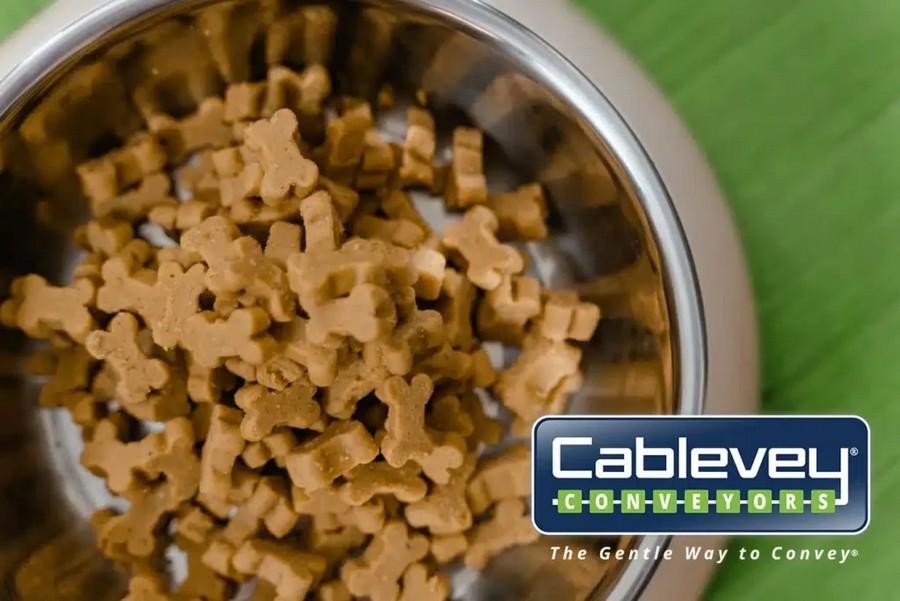 Conveying Systems
Conveying Systems

3+ MIN





10/08/2023
Pet Food Industry Trends for 2023
Growth is a great opportunity, but it also requires planning when it comes to how pet foods are conveyed in your facility. How are companies preparing to handle this type of growth at their processing facilities?
In October 2022, Cablevey Conveyors commissioned the independent research firm, Ascend2, to conduct a research study titled Evaluating and Implementing New Conveyor Systems. The 16-page study (download for free) asked 290 food processing professionals in the United States and the United Kingdom to provide their insight on critical considerations when evaluating conveyor systems.
In this article, we will review and analyze the findings from 72 food processing professionals that are conveying pet food. What are they doing to prepare for growth?
Finding #1: Budgeting for Growth.
85% of facilities processing pet foods are increasing their budget for conveying equipment and maintenance in the next 12 months. 35% tell us that they are increasing significantly the budget needed to meet growth opportunities. Why the increase in the budget? The increase is in response to how much these businesses grew in the past year.
Finding #2: Can your workspaces facilitate needed growth?
An important consideration of growth is your workspaces and facility requirements. What conveying systems are best for the space that you have available?
According to the pet food processing experts surveyed, the #1 conveying system (46%) for maximizing available space is cable and disk conveyors. What are a few questions should you ask when evaluating the right conveyor system to optimize the space at your facility?
Do you have enough floor space or ceiling height to accommodate certain conveyor types? Does the layout of the conveying system take into account easy access for cleaning and maintenance, worker safety, and operational performance? Here is a short video that shows a pet food conveying layout.
Finding #3: Consider maintenance and downtime when you plan.
For pet food, what conveying systems are the most efficient? Cable and disc conveyors lead the pack (by a wide margin) at 54%
What are a few questions should you ask when evaluating the right conveyor system when it comes to maintenance and downtime?
Questions to ask:
How much time will be spent disassembling and cleaning the system? Will maintenance and downtime costs exceed any savings that you realized when purchasing the system?
Finding #4: Don't forget energy efficiency.
What contributes to energy efficiency? The size of the motor and the amount of horsepower required to run a conveying system can have a major impact on production costs. What conveying systems is the most energy efficient for pet foods? Cable and disc conveyors are #1 at 44%.
Here are two questions to ask regarding energy and efficiency:
How much energy will this system use?
Is there a high or a low cut-off point at which this system becomes inefficient?
Conclusion
The pet food industry is growing and evolving. This research study provides insight into the specifics of how industry professionals are preparing for that growth and making the best decisions for their facilities.
The research points to cable and disc conveyors as the superior solution for pet foods. Tubular conveyors help streamline pet food processing and maintain both quality and proper proportions in nutritional mixes, snack foods, and other pet food products, product characteristics important to pet food purchasers.
To find out if a Cablevey system is the best solution for conveying your pet food, have the Cablevey Testing Center perform a free test for you. The Testing Center will provide you with the data to help you make the most informed decision for your specific need.
This article only covers a portion of the finding from the Ascend2 research study. Download Evaluating and Implementing New Conveyor Systems for more insight into the food processing industry.
by Cablevey Conveyor
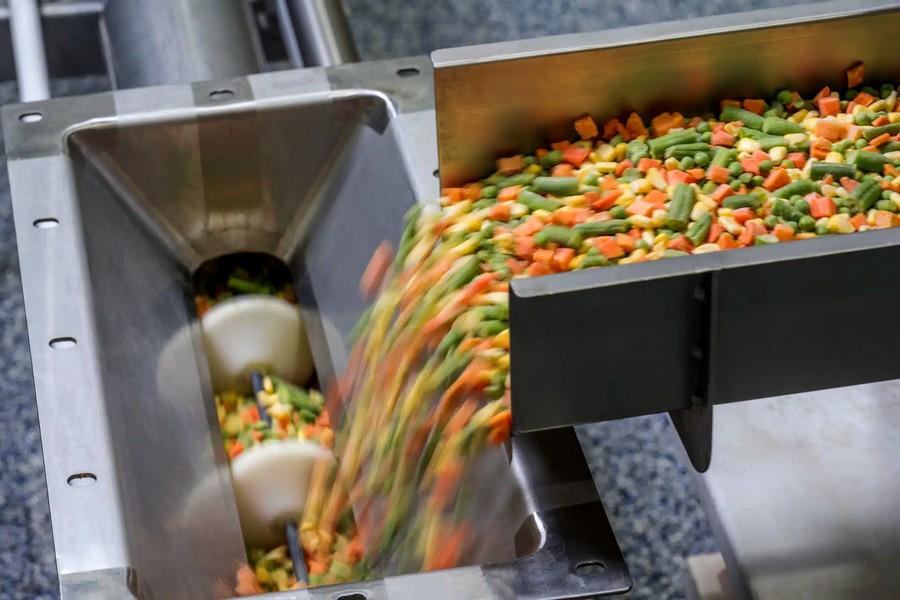 Conveying Systems
Conveying Systems

11+ MIN





05/05/2023
Your Go-To Guide For Stainless Steel Conveyors In Food Processing
Automated conveyor systems play a vital role in virtually every stage of food processing, from transporting raw ingredients to packaging finished products. What's more, in the food and beverage industry, hygiene is of the utmost importance. That's why stainless steel conveyors are such a popular choice in this sector (especially for conveying food).
Stainless steel is easy to clean and disinfect, making it the ideal material for conveying foodstuffs in accordance with FDA regulations. In this blog post, we will explore the use of stainless steel construction conveyors in the food production industry in more detail. We'll also look at some of the benefits of using this type of conveyor and explain how you can keep it clean and sanitary
What is stainless steel?
Let's start by taking a closer look at stainless steel. This is an alloy of iron, chromium, and, in some cases, other metals such as nickel and molybdenum. The main feature of stainless steel that makes it so suitable for food handling is its resistance to corrosion. This means that it won't rust when it comes into contact with oxygen. Regular steel (carbon steel), when exposed to oxygen, will transform into iron oxide (rust). Rust is porous and can flake off, becoming an excellent source of contamination. Stainless steel, on the other hand, forms a protective chromium oxide layer on its surface that prevents oxygen from reaching the iron beneath. As a result, it is much more resistant to corrosion than regular steel. What's more, stainless steel is also non-toxic and non-allergenic, which is important when you are conveying food products.
Benefits of stainless steel conveyors
Corrosion resistance is just one of the many benefits of using a stainless steel conveying solution in food processing. Let's take a look at some of the others:
No product contamination – Unlike other materials that degrade over time and release particles into the product, stainless steel is inert and won't contaminate the conveyed material. It is also non-porous, meaning bacteria and other contaminants cannot become trapped on the surface.
Easy to clean and sanitize – Because of its smooth surface, stainless steel is very easy to clean and disinfect. This is essential in the food industry, where hygiene is of paramount importance. We'll get into more detail about cleaning stainless steel conveyor solutions later on.
Doesn't change food flavor – Outgassing is a phenomenon that can occur with certain materials, whereby they release gasses that can change the taste of food. Stainless steel is completely inert and doesn't outgas, so you can be sure your product will not be affected.
Resistant to high temperatures – Stainless steel can withstand high temperatureswithout being damaged. This means it can be used in applications where the product being conveyed is hot.
Resistant to low temperatures – Just as stainless steel can withstand high temperatures, it is also resistant to low temperatures. This means it can be used in applications where the product being conveyed is frozen.
Of course, these are not the only benefits of using a conveyor system for food made from stainless steel. Stainless steel is also a very strong material that is able to support heavy loads, making it ideal for use in the food industry.
Is a stainless steel conveyor sanitary?
To start answering the question of whether stainless steel food processing equipment is sanitary, we first need to understand what the term 'sanitary' means.
In the food industry, the term 'sanitary' refers to an environment or piece of equipment that is free from contaminants such as bacteria, viruses, and other microorganisms. This is different from the term 'clean,' which simply refers to the absence of visible dirt. A piece of equipment can be clean but not sanitary, for example, if it has been cleaned with a cleaning solution that is itself contaminated.
So, are stainless steel conveyors sanitary?
The answer is no – no material is inherently sanitary. However, stainless steel is one of the most hygienic materials that you can use in food handling. This is because it is non-porous and non-absorbent, meaning that bacteria and other contaminants cannot become trapped on the surface. It is also made for easy cleaning and disinfection.
That said, even stainless steel conveyors can become contaminated if they are not used and maintained properly. It is important to remember that bacteria and other microorganisms are everywhere – on our skin, in the air, and even on stainless steel. If left untreated, these contaminants can quickly multiply, compromise food safety, and cause foodborne illnesses.
This is why it is so important to follow good hygiene practices when using stainless steel conveyors. In particular, you should ensure that the conveyor is cleaned and disinfected regularly, even if it is made of a food-grade material.
Cleaning and sanitizing stainless steel conveyors
Each facility has its own cleaning and sanitizing procedures developed according to the products being conveyed and the level of contamination risk. However, there are some basic steps that you can follow in cleaning and sanitizing your stainless steel conveyor:
Remove loose dirt and debris – The first step is to remove any loose dirt and debris from the surface of the conveyor. The reason why it is important to do this first is that you don't want to spread contaminants around when you are cleaning. You can remove loose dirt and debris by brushing, vacuuming, or using compressed air.
Pre-rinse – After you have removed the loose contaminants, you should pre-rinse the conveyor with water. This helps to remove any remaining impurities from the conveyor surface.
Apply cleaning solution – Which cleaning agent you use will depend on the type of contaminants present and the manufacturer's recommendations.
Rinse – Once you have applied the cleaning solution, you should rinse the conveyor with clean water. This helps to remove any remaining cleaning solution and contaminants from the surface.
Inspect – Before sanitizing, you should inspect the conveyor to ensure it is clean. In particular, you should look for any areas that may have been missed during the cleaning process.
Apply sanitizing solution – The final step is to apply a sanitizing solution to the conveyor. This helps to kill any remaining bacteria and other microorganisms. Once you have applied the sanitizing solution, you should rinse the conveyor with clean water.
Note that some sanitizing agents may not need to be rinsed off, so be sure to check the solution manufacturer's instructions.
Increase cleaning efficiency
It's no secret that cleaning, sanitizing, and maintaining conveyors can be time-consuming. In fact, according to our State Of Conveying 2022 report, 54% of food processing managers and engineers said that cleaning and maintenance are the most challenging aspects of conveying. Reasons for this include:
Downtime – When conveyors are taken offline for cleaning, it can lead to significant downtime and lost productivity.
Cleaning frequency – The more often a conveyor is used, the more often it will need to be cleaned. This can make it difficult to keep up with the cleaning times and schedule, especially if the conveyor is in constant use.
Complexity – Some food product handling conveyors are more complex than others, which can make them more difficult to clean. For example, some conveyors have many nooks and crannies that can be difficult to reach.
Fortunately, there are methods you can use to increase the efficiency of your cleaning process. Have you come across clean-in-place (CIP) mechanisms?
Clean-in-place systems
A CIP system is a method of cleaning that uses special equipment to clean the interior surfaces of the conveyor without disassembling it. CIP systems are often used in the food and beverage industry, as they are an effective way to clean complex equipment quickly and efficiently. Cablevey offers two main types of CIP systems:
Dry cleaning – Using brushes, air knives, urethane wiper discs, and special sponges with sanitizers. Dry cleaning is typically used for conveyors that move material that is not wet or sticky.
Wet cleaning – Using water jets, sanitizers, and detergents. Wet cleaning is typically used for conveyors that move wet or sticky material.
In this day and age, where every minute counts towards productivity, a CIP system can make a big difference.
the conveyor type matter?
If you choose a stainless steel conveyor for your food processing plant, does the type of conveyor matter? The answer is yes; of course, it does. The material the conveyor is made of is just one small part of the equation. You also need to consider the environment in which the conveyor will be used and the type of product that will be moved on the conveyor. Here are some common food manufacturing conveyors:
Belt conveyor
Perhaps the most widespread of all conveyors, belt conveyors are generally used to transport light to medium-weight products. A belt conveyor is composed of a belt that rests on two or more pulleys, which in turn rotate on shafts. The pulleys and shafts are powered by an electric motor. The belt on this type of conveyor can be made from a variety of materials. You can get plastic belt conveyors, rubber belt conveyors, and even metal belt conveyors. Not all of these represent a food-grade conveyor, though. Benefits:
Good for fragile materials
Can transport a variety of products
Drawbacks:
Not for steep inclines or vertical conveying
Not for wet or sticky products
If not enclosed, it poses a high risk of contamination
Bucket conveyor
Bucket conveyors, or bucket elevators, are composed of a series of buckets that are connected to a belt or chain. The buckets lift materials, such as grain, up to the top of the conveyor, where they are discharged into a chute. Even though horizontal bucket conveyors exist, incline conveyor options are more common, as they take up less space and can be used in a variety of settings.
Benefits:
Low driving power – energy efficient
Good for facilities with small floor plans
Good for inclines and vertical conveying
Drawbacks:
Ridiculously difficult to clean and maintain because of a lot of moving parts
Pneumatic conveyor
The main principle of material conveying in pneumatic conveyors is entrainment. In this type of conveyor, air is used to move materials through a system of tubes. A blower or a vacuum pump can generate the airflow.
Benefits:
High conveying speeds
Low preventative maintenance and cleaning costs
Flexible design – suitable for a variety of settings
Drawbacks:
Extremely hard on conveyed materials – material damage is common
It requires a lot of power to control the speed
Can be noisy
Tubular chain conveyor
A tubular chain conveyor is composed of a chain that runs inside a tube. Circular discs are evenly spaced along this chain, creating space between them for the conveyed material to fit into. The discs move along the tube, propelling the material forward.
Benefits:
Fully enclosed
Can be used for inclines and vertical conveying
Gentle conveying
Drawbacks:
Chain is in direct contact with conveyed material – high risk of contamination
Difficult to clean and maintain
Tubular cable and disc conveyor
We saved the best for last. For specific material types, such as breakfast cereal, snack foods, nuts, beans, coffee beans, rice, and similar, tubular cable and disc conveyors are the best option. These conveyors work on a similar principle as tubular chain conveyors, with one major difference – instead of chains and discs, they use cables and discs. There is no direct food contact with the cable, which decreases the risk of contamination. Also, these conveyors are easier to clean and maintain.
Benefits:
Fully enclosed
Gentle conveying – suitable for fragile materials
Extremely low risk of contamination
Easy to clean and maintain
Drawbacks:
Not for viscous or sticky materials
Which conveyor to choose?
A stainless steel conveyor system is only as good as the application it's being used for. Different conveyors are better suited for different tasks. To help you make a better decision, here are the top considerations you need to take into account:
Conveyor type – As we've seen, there are many different types of conveyors. Make sure to choose the one that's best suited to your needs.
Material type – Not all materials can be conveyed by all conveyors. Some materials are too fragile, while others are too dense. Make sure that the conveyor you choose can handle your material.
Conveyor throughput – The amount of material that needs to be conveyed will play a big role in deciding which type of food processing conveyor to choose.
Conveyor size and layout – Not every conveyor is suitable for every facility. The size of your facility and the layout of your production line will play a big role in deciding which conveyor to choose.
Some other considerations are the cost of the conveyor, the energy efficiency, and how easy or difficult it is to clean and maintain the conveyor.
Go for a sanitary design
We've already explained how no material is completely safe from contamination. Even if you choose a food conveyor system that's easy to clean, there's always a risk of bacteria and other germs getting into the food. That's why it's important to go for a sanitary conveyor design. A hygienic design minimizes the risk of contamination. It includes:
Easy access for cleaning – The conveyor should be designed in a way that allows easy access for cleaning. All parts of the conveyor should be accessible for cleaning, and there should be no dead spots where bacteria can accumulate.
No traps in the conveyor frame – The conveyor frame design has to prevent food from getting trapped in it. All food should be able to fall freely from the conveyor, without getting caught in any nooks or crannies.
No areas where water can accumulate – The conveyor should be designed to prevent water from accumulating anywhere on it. All wet areas should drain quickly, and there should be no places where water can pool.
No fasteners – Welds should be used instead of fasteners to prevent food from getting trapped in them.
It stands to reason that deciding exactly which type of stainless steel conveyor to choose for your food processing facility is a big decision. But with the right information, you can make the best choice for your needs.
Conclusion
Here are the main takeaways from this article:
Stainless steel isn't sanitary by default. But it is an excellent material for conveyors because it's easy to clean and doesn't rust.
The cable and disc conveyor is the best type of stainless steel conveyor for food processing applications. These food conveyors are fully enclosed, gentle, and have a low risk of contamination.
When choosing an industrial conveyor, consider the type of conveyor, the material you're conveying, the throughput, the size and layout of your facility, and the cost.
Make sure to choose a conveyor with a sanitary design to minimize the risk of contamination. A sanitary design includes easy access for cleaning, no traps in the conveyor frame, no areas where water can accumulate, and no fasteners.
Ready to buy a stainless steel conveyor for your food processing facility? Cablevey Conveyor can help you find the perfect one for your needs. Contact Cablevey today to get started
By Cablevey Conveyor
Source: All Pet Food



